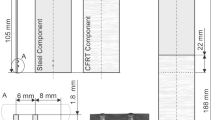Abstract
This paper presents an integrated passive damping approach in hybrid metal-CFRP parts for structural applications. In this concept a viscoelastic material is embedded in the joint zone of the hybrid component. To examine the connection strength single-lap-joint specimens were produced and tested and the influence of the used material combinations, different surface structures, and different process parameters i.e. the moment of cross-linking were evaluated. Afterwards, the metal-CFRP hybrids were tested in quasi-static tests to assess their connection strength and failure behaviour. Dynamic cyclic tensile tests with step-wise increased loading conditions were performed to determine the specimens damping behaviour and to estimate their fatigue performance. Finally, these results are compared to a state of the art metal-CFRP hybrid with rivets connecting both materials.







Similar content being viewed by others
References
Ashworth S, Rongong J, Wilson P, Meredith J (2016) Mechanical and damping properties of resin transfer moulded jute-carbon hybrid composites. Compos B Eng 105:60–66. https://doi.org/10.1016/j.compositesb.2016.08.019
Assarar M, Zouari W, Sabhi H, Ayad R, Berthelot JM (2015) Evaluation of the damping of hybrid carbon-flax reinforced composites. Compos Struct 132:148–154. https://doi.org/10.1016/j.compstruct.2015.05.016
Bae JH, Jung KC, Yoo SH, Chang SH, Kim M, Lim T (2015) Design and fabrication of a metal-composite hybrid wheel with a friction damping layer for enhancement of ride comfort. Compos Struct 133:576–584. https://doi.org/10.1016/j.compstruct.2015.07.113
Berger D, Brabandt D, Bakir C, Hornung T, Lanza G, Summa J, Schwarz M, Herrmann HG, Pohl M, Stommel M (2017) Effects of defects in series production of hybrid cfrp lightweight components—detection and evaluation of quality critical characteristics. Measurement 95:389–394
DIN EN: 2243-1:2007-04, Aerospace series - Non-metallic materials - Structural adhesives - Test method - Part 1: Single lap shear
Hoa SV, Ouellette P (1984) Damping of composite materials. Polym Compos 5(1984):334–338
Lakes RS (2002) High damping composite materials: effect of structural hierarchy. J Compos Mater 36(3):287–297
Li Y, Cai S, Huang X (2017) Multi-scaled enhancement of damping property for carbon fiber reinforced composites. Compos Sci Technol 143:89–97. https://doi.org/10.1016/j.compscitech.2017.03.008
Marsh ER, Slocum AH (1996) An integrated approach to structural damping. Precis Eng 18(2–3):103–109. https://doi.org/10.1016/0141-6359(96)00051-7
Mukhopadhyay S, De S (1991) Miscibility of self-vulcanizable rubber blend based on epoxidized natural rubber and chlorosulphonated polyethylene: effect of blend composition, epoxy content of epoxidized natural rubber and reinforcing black filler. Polymer 32(7):1223–1229. https://doi.org/10.1016/0032-3861(91)90225-8
Pohl M, Stommel M (2016) Designing a metal-cfrp-hybrid by using a structured polymeric component on the interface. In: Proceeding of the 17th European Conference on Composite Materials. 26–30th June 2016, Munich, Germany, European Society for Composite Materials
Pohl M, Stommel M, Baumann F, Berger D, Lanza G, Summa J, Schwarz M, Herrmann HG (2017) Development structures for intrinsic hybrids. WT Werkstattstechnik 107(7–8):546–550
Prasad DS, Shoba C, Varma KR (2015) Damping behavior of commonly used reinforcement powders—an experimental approach. Eng Sci Technol Int J 18(4):674–679. https://doi.org/10.1016/j.jestch.2015.05.001
Wegman RF, Van Twisk J (2013) 9 rubbers. In: Surface Preparation Techniques for Adhesive Bonding, pp. 131–145. https://doi.org/10.1016/B978-1-4557-3126-8.00009-9
Zang L, Chen D, Cai Z, Peng J, Zhu M (2016) Preparation and damping properties of an organic-inorganic hybrid material based on nitrile rubber. Compos B Eng. https://doi.org/10.1016/j.compositesb.2016.11.038
Acknowledgements
This research was supported by the German National Science Foundation (DFG) within the Priority Program 1712.
Author information
Authors and Affiliations
Corresponding author
Rights and permissions
About this article
Cite this article
Pohl, M., Stommel, M. Intrinsic CFRP-metal-hybrids with rubber interface for the improvement of the damping behaviour. Prod. Eng. Res. Devel. 12, 153–159 (2018). https://doi.org/10.1007/s11740-018-0792-5
Received:
Accepted:
Published:
Issue Date:
DOI: https://doi.org/10.1007/s11740-018-0792-5




